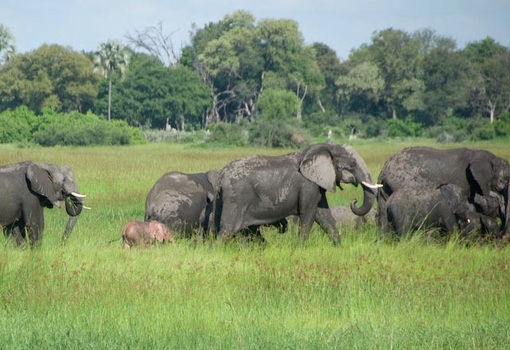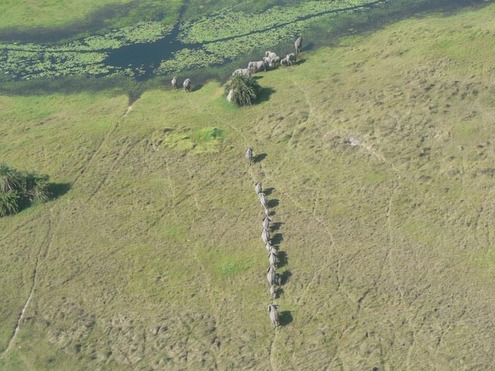Aerial survey of northern Botswana -Resultshttp://www.wildlifeextra.com/go/news/botswana-survey.html
Botswana wildlife survey January 2011. Elephants Without Borders (EWB), with the support of the Dept. of Wildlife & National Parks and the San Diego Zoo, have recently completed flying a fixed wing aerial survey, counting elephants and wildlife species, over northern Botswana. Wildlife counted Wildlife species counted included large and small herbivores, such as: Elephants, roan, sable, zebra, giraffe, eland, kudu, impala, lechwe, springbok, buffalo, wildebeest, hartebeest, tsessebe, waterbuck, warthog, and hippos; predators were also noted when seen. Other observations recorded included: types of elephant herds (bull or family groups), elephant carcasses, elephant bones and if possible whether tusks were intact or missing. EWB also recorded observations of selected large birds and nesting sites. The birds counted included: critically endangered wattled crane, lappet-faced vultures, ground hornbill, ostrich, saddle-bill storks, fish eagles, and Bateleur eagles. |
Due to the growing concern about the
impact elephants and fire are having on large trees in Botswana and considering
Baobabs are iconic trees, the team also counted Baobab trees and took note of
their, size and recorded the extent of damage to each tree seen. Additional
notes were taken on environmental conditions, such as the extent of bush fires
and the structural integrity of Botswana's veterinary fence lines and whether
livestock or wildlife had crossed them.
The information on elephant and wildlife numbers, distribution, and demographic characteristics from this study will be incorporated into population models to better understand a variety of research and management questions relating to wildlife ecology and conservation management in Botswana. Other management issues where this study may contribute important information include: Illegal hunting, veterinary control measures, hunting quotas and habitat monitoring. The results of this project may also help promote conservation efforts that seek to ultimately enhance economic opportunities for rural communities in the region.
43,000 kilometres flown The four member survey team flew the survey over a three month period. Approximately 250 hours were spent in small single-engine plane flying the survey. The distance covered by the team was approximately 43,000 kilometres, most of which was spent flying along straight transect lines over Botswana's varied terrain. The distance covered by the survey team, is longer than the circumference of the Earth at the Equator!
The study area essentially encompassed the entire elephant range in northern Botswana of approximately 115,800 km2. The survey boundaries extended across the southern extent of the Okavango Delta following the Southern Buffalo Fence, eastward to the Boteti River, while the eastern boundary extended to the Zimbabwe border, then north to Kasane. The northern boundary followed along the Chobe, Linyanti and Kwando Rivers. Over high density wildlife areas, such the Okavango Delta, the sampling coverage was about 22%, the highest survey coverage ever flown over such a vast area of northern Botswana, making this Botswana's first aerial survey conducted with such a high sampling intensity.
EWB plans to publicize the results of this important aerial survey at an official launch of the report early next year. In addition several presentations on the project results will be presented to key stakeholders. The primary objectives of these presentations and meetings will be to share information obtained from this study and from the on-going research activities of EWB. EWB hopes the results of this collaborative survey with the DWNP will have fundamental conservation management implications for land-use planning and conservation efforts in Botswana.
Elephants Without Borders (EWB) is a non-profit charitable organization based in Kazangula. EWB is dedicated to conserving wildlife and natural resources and is the country's leading regional cross-border research project focused on elephant conservation and management. Their projects' work has contributed to many scientific publications, newspaper and magazine articles and is featured in a film by Afriscreen Films for the BBC Natural History Unit and Animal Planet. To learn more about Elephants Without Borders activities, visit their website: www.elephantswithoutborders.org
The project was led by EWB's founder, and San Diego Zoo's Institute for Conservation Research scientist Dr. Mike Chase, coordinated by EWB's program manger, Kelly Landen and piloted by Mr. Mike Holding from Afriscreen Films
The information on elephant and wildlife numbers, distribution, and demographic characteristics from this study will be incorporated into population models to better understand a variety of research and management questions relating to wildlife ecology and conservation management in Botswana. Other management issues where this study may contribute important information include: Illegal hunting, veterinary control measures, hunting quotas and habitat monitoring. The results of this project may also help promote conservation efforts that seek to ultimately enhance economic opportunities for rural communities in the region.
43,000 kilometres flown The four member survey team flew the survey over a three month period. Approximately 250 hours were spent in small single-engine plane flying the survey. The distance covered by the team was approximately 43,000 kilometres, most of which was spent flying along straight transect lines over Botswana's varied terrain. The distance covered by the survey team, is longer than the circumference of the Earth at the Equator!
The study area essentially encompassed the entire elephant range in northern Botswana of approximately 115,800 km2. The survey boundaries extended across the southern extent of the Okavango Delta following the Southern Buffalo Fence, eastward to the Boteti River, while the eastern boundary extended to the Zimbabwe border, then north to Kasane. The northern boundary followed along the Chobe, Linyanti and Kwando Rivers. Over high density wildlife areas, such the Okavango Delta, the sampling coverage was about 22%, the highest survey coverage ever flown over such a vast area of northern Botswana, making this Botswana's first aerial survey conducted with such a high sampling intensity.
EWB plans to publicize the results of this important aerial survey at an official launch of the report early next year. In addition several presentations on the project results will be presented to key stakeholders. The primary objectives of these presentations and meetings will be to share information obtained from this study and from the on-going research activities of EWB. EWB hopes the results of this collaborative survey with the DWNP will have fundamental conservation management implications for land-use planning and conservation efforts in Botswana.
Elephants Without Borders (EWB) is a non-profit charitable organization based in Kazangula. EWB is dedicated to conserving wildlife and natural resources and is the country's leading regional cross-border research project focused on elephant conservation and management. Their projects' work has contributed to many scientific publications, newspaper and magazine articles and is featured in a film by Afriscreen Films for the BBC Natural History Unit and Animal Planet. To learn more about Elephants Without Borders activities, visit their website: www.elephantswithoutborders.org
The project was led by EWB's founder, and San Diego Zoo's Institute for Conservation Research scientist Dr. Mike Chase, coordinated by EWB's program manger, Kelly Landen and piloted by Mr. Mike Holding from Afriscreen Films
Rare Pink elephant spotted by Mike Holding

By Mike Holding:
I spotted the elephant at our film camp, in the Chitabe area of the Okavango, where we shot a lot of the "Nature's Great Events" footage. (particularly that great hippo sequence)
It was with a herd of about 80 elephants, that crossed the river in front of camp. We only saw it for a couple of minutes, as the herd crossed the river quickly and moved away. I took the pictures.
I have spent 20 years filming in the Okavango, and we come across strange sightings quite often, but this was definitely a first!
This was a really exciting moment for everyone in camp – we knew it was a rare sighting, and no one could believe their eyes!
We asked elephant expert, Dr. Mike Chase a few questions:
How come it is pink? Presumably albinos are white - is this an albino?
Dr Chase: Albino elephants are not strictly white. Although often depicted as snow white, their skin is normally a soft reddish-brown, or pink such as the one in the photo.
If the elephant calf is a true albino, it would have pale pink eyes, white tail hairs and pink skin (the pink skin behind the ears is suggestive of true albinism). A leucistic animal is white, but has dark eyes, and can have some pigmentation. The calf appears to have no markings and is uniformly pink over its entire body. It is unlikely that this calf will get darker with age, as albinism is a permanent condition, but these young albino elephants seem to disappear.
I suspect the harsh sun makes survival difficult, that is why these animals are very rare. Albinos are likely to go blind, making survival to adult hood very difficult.
How unusual is this kind of thing - in terms of everywhere, and also in Botswana?
What does this mean for the baby - will it make her more susceptible to sunlight, attacks from predators, poaching, rejection from peers etc.
I have only come across three references to albino claves which have occurred in Kruger National Park – South Africa. This is probably the first documented sighting of an albino elephant in northern Botswana. We have been studying elephants in the region for nearly ten years now and this is the first documented evidence of an albino calf I have come across. I have never heard of or read any account of an albino elephant in Northern Botswana. The occurrence of albino elephants in Asian elephants is more common, but rare in African elephants.
What happens to these young albino calves remains a mystery. Albinism has never been recorded in adult African elephants, and very rarely in calves. Surviving this very rare phenomenon is very difficult in the harsh African bush. The glaring African sun, may cause blindness and skin problems. An elephant in his early teenage years went blind in Hwange National Park, and I suspect they will also suffer from skin problems related to severe sun burn.
But I have learned that elephants are highly adaptable, intelligent and masters of survival. Because this elephant calf was sighted in the Okavango delta he may have a greater chance of survival. He can seek refuge under the large trees, and cake himself in a thick mud which will protect him from the sun.
For the first time we have the ability to monitor the survival strategies of this calf and how it might adapt to its rare skin colour. Already the 2-3 month old calf tended to walk in the shade of it’s mother. This behaviour suggests it is aware of its susceptibility to the harsh African sun, and adapted a unique behaviour to improve its chances of survival.
Read the story on BBC News
I spotted the elephant at our film camp, in the Chitabe area of the Okavango, where we shot a lot of the "Nature's Great Events" footage. (particularly that great hippo sequence)
It was with a herd of about 80 elephants, that crossed the river in front of camp. We only saw it for a couple of minutes, as the herd crossed the river quickly and moved away. I took the pictures.
I have spent 20 years filming in the Okavango, and we come across strange sightings quite often, but this was definitely a first!
This was a really exciting moment for everyone in camp – we knew it was a rare sighting, and no one could believe their eyes!
We asked elephant expert, Dr. Mike Chase a few questions:
How come it is pink? Presumably albinos are white - is this an albino?
Dr Chase: Albino elephants are not strictly white. Although often depicted as snow white, their skin is normally a soft reddish-brown, or pink such as the one in the photo.
If the elephant calf is a true albino, it would have pale pink eyes, white tail hairs and pink skin (the pink skin behind the ears is suggestive of true albinism). A leucistic animal is white, but has dark eyes, and can have some pigmentation. The calf appears to have no markings and is uniformly pink over its entire body. It is unlikely that this calf will get darker with age, as albinism is a permanent condition, but these young albino elephants seem to disappear.
I suspect the harsh sun makes survival difficult, that is why these animals are very rare. Albinos are likely to go blind, making survival to adult hood very difficult.
How unusual is this kind of thing - in terms of everywhere, and also in Botswana?
What does this mean for the baby - will it make her more susceptible to sunlight, attacks from predators, poaching, rejection from peers etc.
I have only come across three references to albino claves which have occurred in Kruger National Park – South Africa. This is probably the first documented sighting of an albino elephant in northern Botswana. We have been studying elephants in the region for nearly ten years now and this is the first documented evidence of an albino calf I have come across. I have never heard of or read any account of an albino elephant in Northern Botswana. The occurrence of albino elephants in Asian elephants is more common, but rare in African elephants.
What happens to these young albino calves remains a mystery. Albinism has never been recorded in adult African elephants, and very rarely in calves. Surviving this very rare phenomenon is very difficult in the harsh African bush. The glaring African sun, may cause blindness and skin problems. An elephant in his early teenage years went blind in Hwange National Park, and I suspect they will also suffer from skin problems related to severe sun burn.
But I have learned that elephants are highly adaptable, intelligent and masters of survival. Because this elephant calf was sighted in the Okavango delta he may have a greater chance of survival. He can seek refuge under the large trees, and cake himself in a thick mud which will protect him from the sun.
For the first time we have the ability to monitor the survival strategies of this calf and how it might adapt to its rare skin colour. Already the 2-3 month old calf tended to walk in the shade of it’s mother. This behaviour suggests it is aware of its susceptibility to the harsh African sun, and adapted a unique behaviour to improve its chances of survival.
Read the story on BBC News

